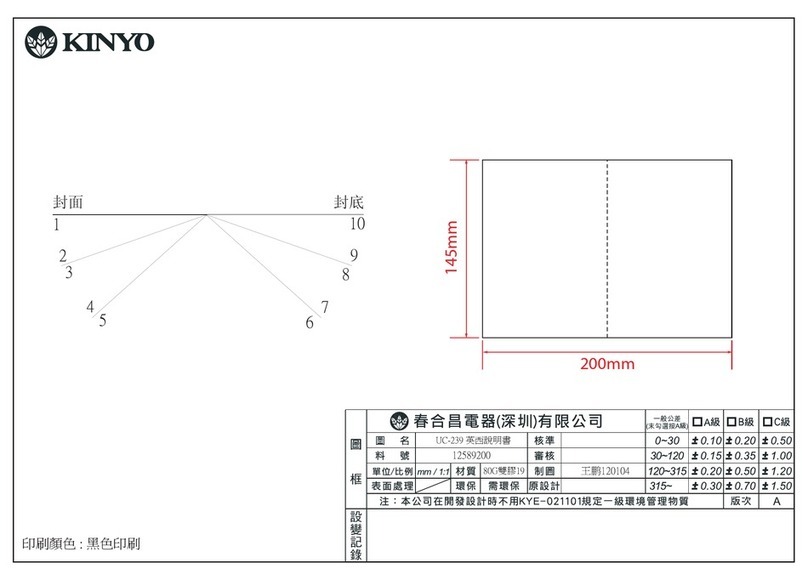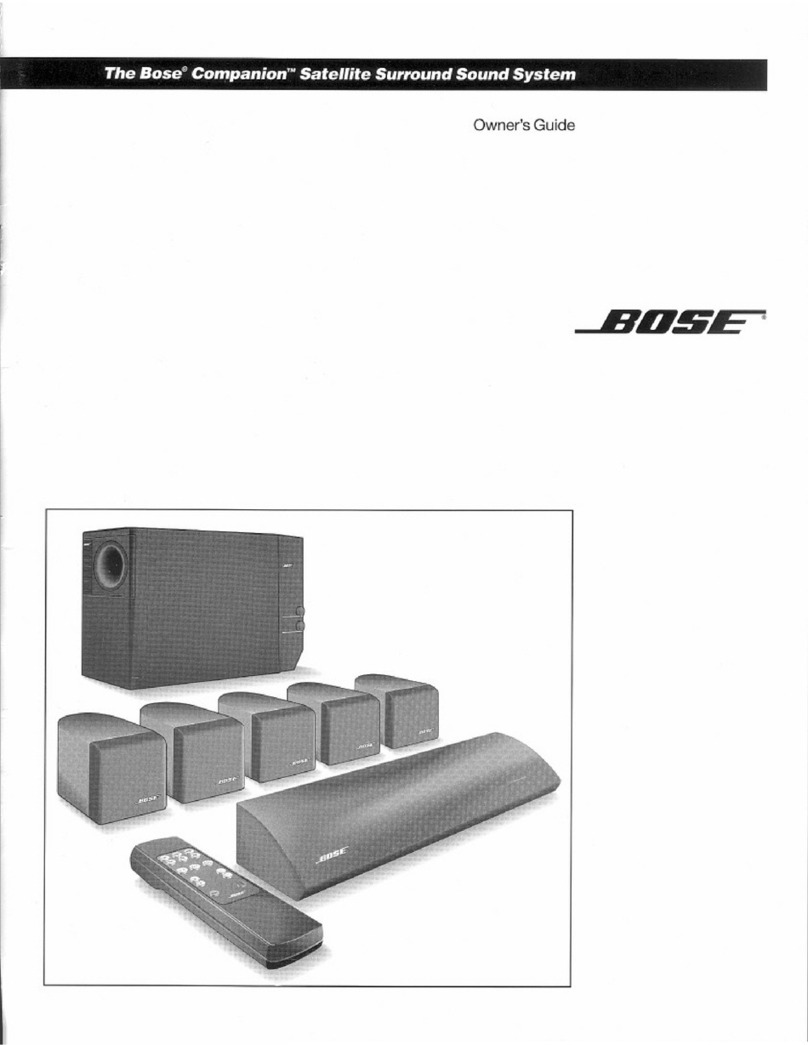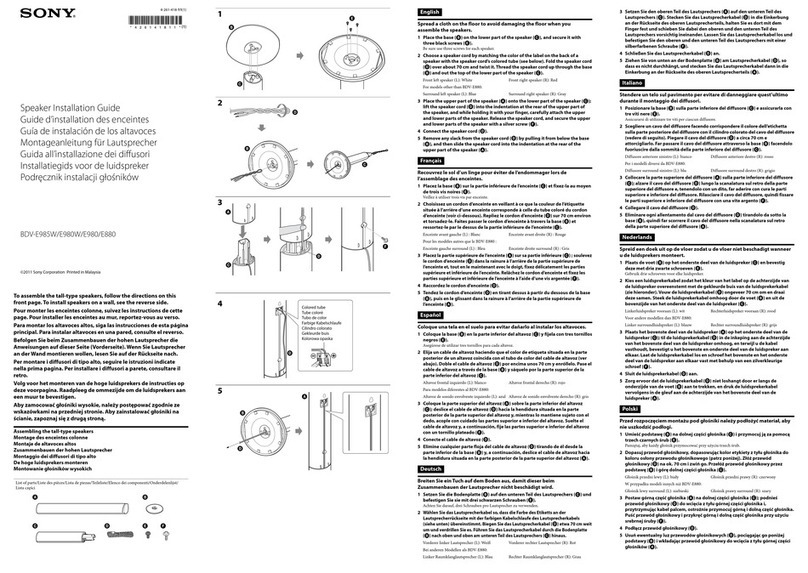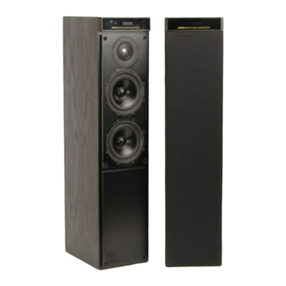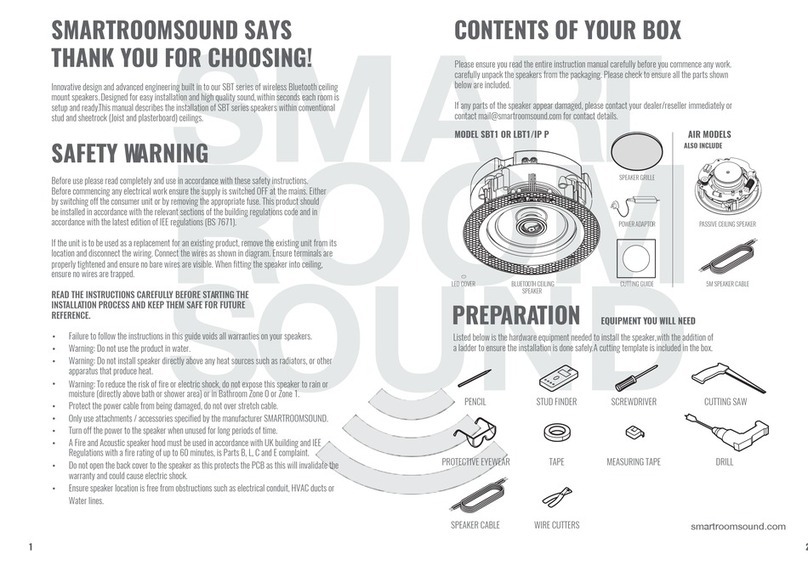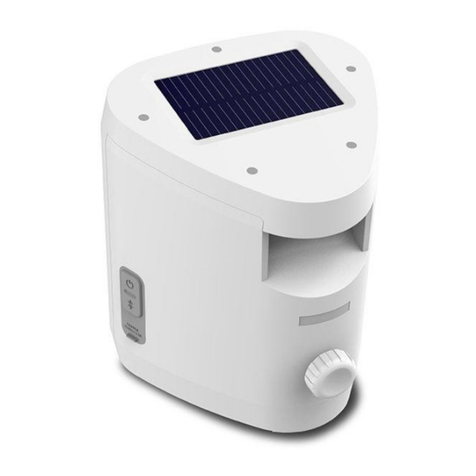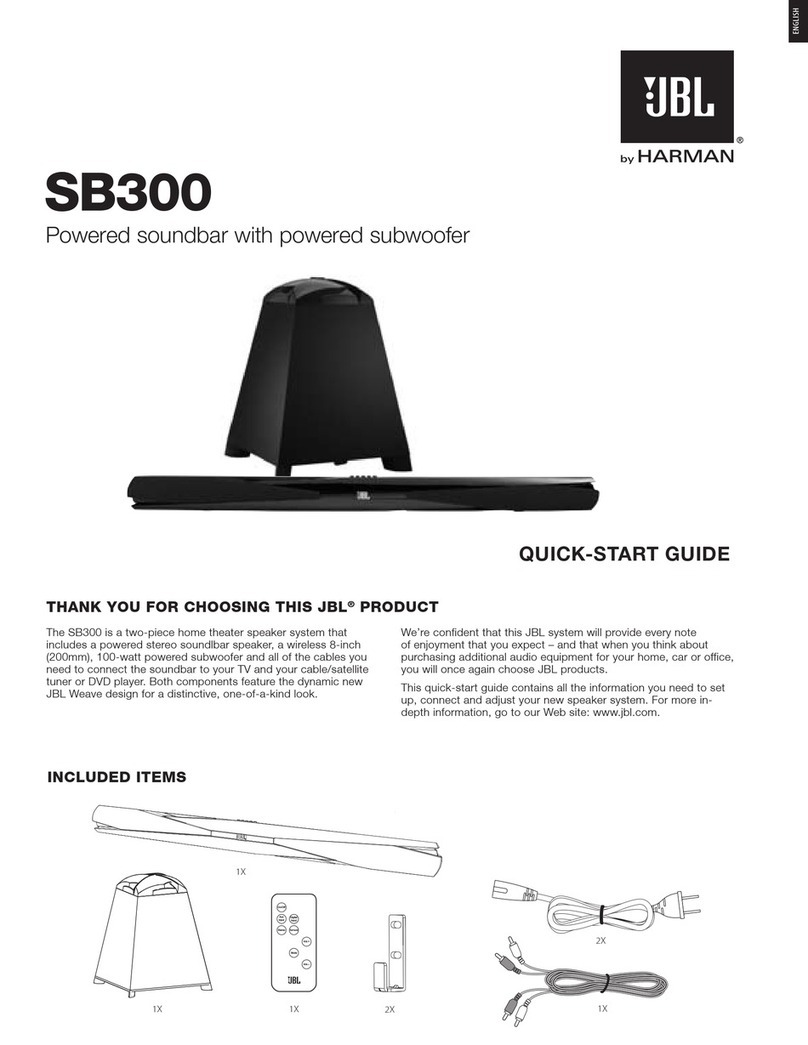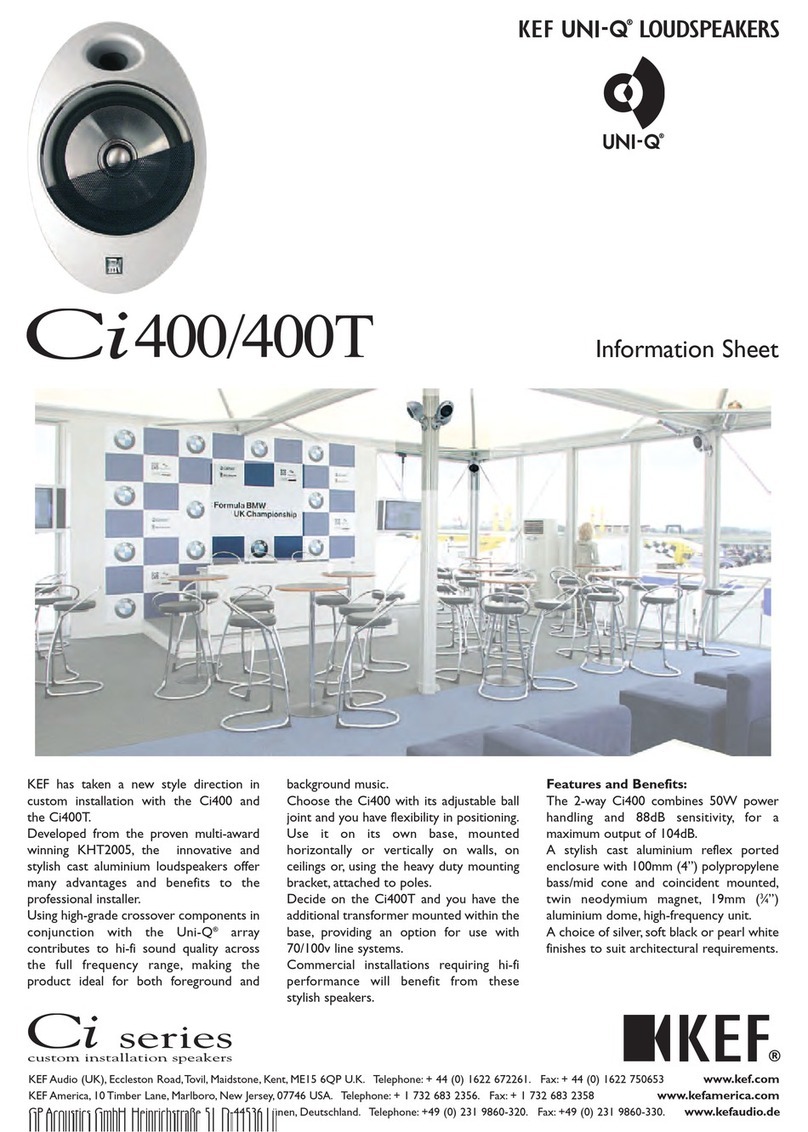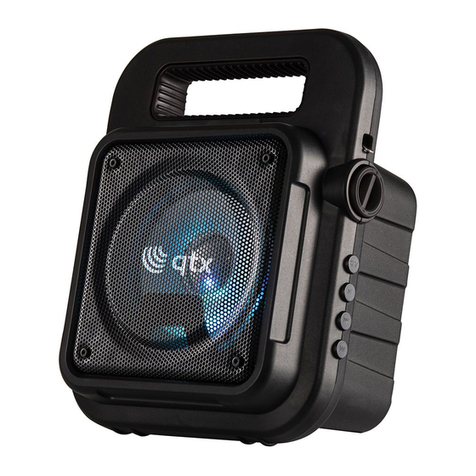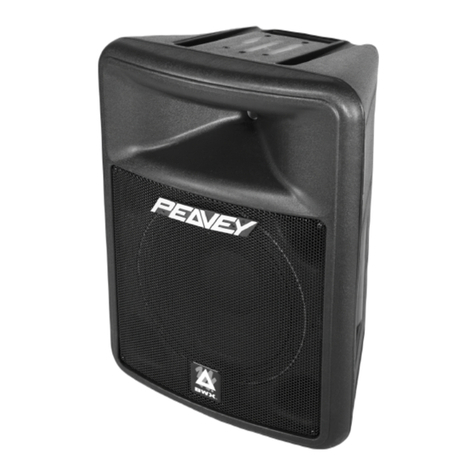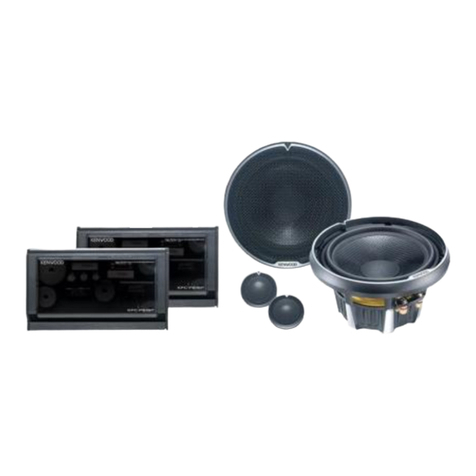Silicon Laboratories UG187 User manual

UG187: Blue Gecko Wireless Starter Kit
with BGM113 Module
User's Guide for the Blue Gecko Bluetooth® Module Wireless
Starter Kit
The Blue Gecko Bluetooth® Module Wireless Starter Kit is an excellent starting point to
get familiar with the BGM113 Bluetooth Module.
The Wireless Starter Kit Mainboard contains sensors and peripherals demonstrating
some of the BGM113's many capabilities. The kit provides all necessary tools for devel-
oping a Silicon Labs wireless application.
KIT FEATURES
• Supplied with BGM111 Blue Gecko
Bluetooth Module Radio Board BRD4300A
• Supplied with BGM113 Blue Gecko
Bluetooth Module Radio Board BRD4301A
• Ethernet and USB connectivity
• SEGGER J-Link on-board debugger
• Debug Multiplexer supporting external
hardware as well as radio board
• Silicon Labs' Si7021 Relative Humidity and
Temperature sensor
• Ultra low power 128x128 pixel Memory
LCD
• LEDs / Push buttons / Reset button
• 20-pin 2.54 mm header for expansion
boards
• Breakout pads for direct access to all radio
I/O pins
• Power sources include USB and CR2032
coin cell holder.
EXTENSION BOARD FEATURES
• Accelerometer
• Buttons and LEDs
• Joystick
• Footprint for I2C Expansion device
ORDERING INFO
• SLWSTK6101B
RADIO BOARD FEATURES
• BGM113 Blue Gecko Bluetooth Module
with 256 kB Flash and 32 kB RAM. (P/N
BGM113)
• Integrated high performance chip anten-
na
• Transmit power up to +3 dBm
• CPU core 32-bit ARM Cortex-M4
SOFTWARE SUPPORT
• Blue Gecko Bluetooth Software
• Blue Gecko Bluetooth SDK
• Example applications for the kit
• iOS and Android applications
silabs.com | Smart. Connected. Energy-friendly. Rev. 1.00

1. Introduction
1.1 Description
The idea behind the SLWSTK6101B is to provide a complete development platform for Silicon Labs' BGM113 Blue Gecko Bluetooth
Modules.
The core of the SLWSTK6101B is the Wireless Starter Kit Mainboard which features an on-board J-Link debugger, a virtual COM port
interface, an LCD display and a humidity/temperature sensor and through holes to access all the pins of the Blue Gecko Bluetooth
Smart Modules.
The WSTK Mainboard is paired with an Blue Gecko BGM113 Bluetooth® Module Radio Board that plugs directly into the mainboard.
The radio board includes the BGM113 with a built-in high performance chip antenna.
The Wireless Starter Kit is also supplied with an expansion board (BRD8006A Add-on Board) that can be connected to the WSTK
mainboard expansion header. The expansion board contains additional peripherals such as an accelerometer, buttons, LEDs, joystick
and a footprint for an I2C authentication device.
1.2 Radio Boards
A Wireless Starter Kit consists of one or more mainboards and radio boards that plug into the connectors on the mainboard. Different
radio boards are available which feature different Silicon Labs devices, which each have unique properties and pinouts.
To keep the mainboard design generic, the actual pin mapping of the kit is done on the radio board itself. This means that each radio
board has a uniqe mapping to the Wireless Starter Kit peripherals and connectors such as buttons, LEDs, the display, the EXP header
and the breakout pads. Because this pin mapping is different for every radio board, it is very important that the correct document be
consulted which shows the kit features in context of the radio board plugged in.
This document describes the Wireless Starter Kit as it behaves with the BGM113 Radio Board (BRD4301A). If the user intends to use
the BGM111 Radio Board (BRD4300A) instead, he or she should refer to UG122: Blue Gecko Wireless Starter Kit with BGM111 Mod-
ule.
1.3 Kit Contents
The following items are contained in the Blue Gecko Wireless Starter Kit box:
• 1x BRD4001A Wireless Starter Kit Mainboard
• 1x BRD4300A Blue Gecko BGM111 Bluetooth® Module Radio Board
• 1x BRD4301A Blue Gecko BGM113 Bluetooth® Module Radio Board
• 1x BRD8006A Blue Gecko Module Kit Add-on Board
• 1x CR2032 Lithium battery
• 1x USB Type A <-> USB Mini-B cables
Please refer to separate documentation for the included radio boards for detailed specifications and RF performance figures.
1.4 Getting Started
Detailed instructions for how to get started with your new Blue Gecko Wireless Starter Kit can be found on the Silicon Labs Simplicity
web pages:
http://www.silabs.com/bluetooth-getstarted
UG187: Blue Gecko Wireless Starter Kit with BGM113 Module
Introduction
silabs.com | Smart. Connected. Energy-friendly. Rev. 1.00 | 1

2. Kit Hardware Layout
The layout of the Blue Gecko Bluetooth® Module Wireless Starter Kit is shown below.
BGM113
Module
Radio Board
Breakout pads
Breakout pads
Ethernet RJ-45
J-Link Debugger
Virtual COM port
Packet Trace
Advanced Energy Monitoring
USB mini-B
J-Link Debugger
Virtual COM port
Packet Trace
Advanced Energy Monitoring
Coin Cell Holder
CR2032 Battery
Power Select Switch
BAT / USB / AEM
2x User Push Buttons 2x User LEDs
Simplicity Connector
External targets:
Virtual COM port
Packet Trace
Advanced Energy Monitoring
Debug Connector
ARM Coresight 19-pin
OUT: External targets
IN: External debug probes
Reset Button
Si7021
Relative Temperature &
Humidity Sensor
EXP Header
Expansion board connector
Expansion Board
3-axis Accelerometer
2x Push Buttons
2x LEDs
Analog Joystick
I2C device footprint
Figure 2.1 SLWSTK6101B Hardware Layout
UG187: Blue Gecko Wireless Starter Kit with BGM113 Module
Kit Hardware Layout
silabs.com | Smart. Connected. Energy-friendly. Rev. 1.00 | 2

3. Kit Block Diagram
An overview of the Blue Gecko Bluetooth® Module Wireless Starter Kit is shown in the figure below.
BGM113
Bluetooth Module
USB Mini-B
Connector
RJ-45 Ethernet
Connector
Debug
UART
AEM
Multiplexer
Debug
UART
Packet Trace
AEM
Debug
UART
Packet Trace
AEM
Simplicity
Connector
Debug
Connector
GPIO
Board
Controller
OUT
IN
MCU
I2C
User Buttons
& LEDs
Si7021
Temperature
& Humidity
Sensor
SPI
ADC Input
GPIO
Accelerometer
BMA280
Analog
Joystick
Buttons
&
LEDs
Footprint for
I2C Expansion
device
I2C
WSTK Mainboard
Peripherals
Expansion Board Peripherals
WSTK Mainboard
Figure 3.1 SLWSTK6101B Block Diagram
UG187: Blue Gecko Wireless Starter Kit with BGM113 Module
Kit Block Diagram
silabs.com | Smart. Connected. Energy-friendly. Rev. 1.00 | 3

4. Connectors
This chapter gives you an overview of the Wireless Starter Kit Mainboard connectivity. The placement of the connectors can be seen in
the figure below.
Simplicity
Connector
In/Out Debug
Header
GND
GND
5V
5V
P25
P24
P27
P26
P29
P28
P31
P30
P33
P32
P35
P34
P37
P36
P39
P38
P41
P40
P43
P42
P45
P44
GND
GND
NC
NC
Radio Board
Connectors
Expansion
Header
GND
GND
VMCU
VMCU
P1
P0
P3
P2
P5
P4
P7
P6
P9
P8
P11
P10
P13
P12
P15
P14
P17
P16
P19
P18
P21
P20
GND
GND
P23
P22
VRF
VRF
3V3
3V3
Figure 4.1 Connector Layout
4.1 Breakout pads
Most of the BGM113's pins are routed from the radio board to breakout pads at the top and bottom edges of the Wireless Starter Kit
Mainboard. A 2.54 mm pitch pin header can be soldered on for easy access to the pins. The figure below shows you how the pins of
the BGM113 maps to the pin numbers printed on the breakout pads. To see the available functions on each, please refer to the
BGM113 Data Sheet.
GND
VMCU
P23 / PD15 / BTN1_LED1
P21 / PD14 / BTN0_LED0
P19 / NC
P17 / NC
GND
P15 / NC
P13 / PC10 / I2C_SDA
P11 / PA1 / VCOM_RX
P9 / PA0 / VCOM_TX
P7 / PD13 / SPI_CS
P5 / PB13 / SPI_CLK
P3 / PB12 / SPI_MISO
P1 / PB11 / SPI_MOSI
GND
GND
5V
5V
NCNC
P45 / NCNC / P44
P43 / NCNC / P42
P41 / NCNC / P40
3V33V3
P39 / NCNC / P38
P37 / tied high / SENSOR_ENABLENC / P36
P35 / NCNC / P34
P33 / NCNC / P32
P31 / NCNC / P30
P29 / NCNC / P28
P27 / PF1 / DBG_TMS_SWDIONC / P26
P25 / PF0 / DBG_TCK_SWCLKNC / P24
GNDGND
VRF
GND
VMCU
NC / P22
NC / P20
NC / P18
NC / P16
GND
NC / P14
I2C_SCL / PC11 / P12
NC / P10
NC / P8
NC / P6
NC / P4
VCOM_RTS / PF3 / P2
VCOM_CTS / PF2 / P0
VRF
J101 J102
Figure 4.2 Radio Board Pin Mapping on Breakout Pads
UG187: Blue Gecko Wireless Starter Kit with BGM113 Module
Connectors
silabs.com | Smart. Connected. Energy-friendly. Rev. 1.00 | 4

4.2 Expansion header
On the right hand side of the board an angled 20 pin expansion header is provided to allow connection of peripherals or plug-in boards.
The connector contains a number of I/O pins that can be used with most of the BGM113 Blue Gecko's features. Additionally, the VMCU,
3V3 and 5V power rails are also exported.
The connector follows a standard which ensures that commonly used peripherals such as an SPI, a UART and an I2C bus are available
on fixed locations in the connector. The rest of the pins are used for general purpose I/O. This allows the definition of expansion boards
that can plug into a number of different Silicon Labs starter kits.
The figure below shows the pin assignment of the expansion header for the Blue Gecko Bluetooth® Module Wireless Starter Kit. Be-
cause of limitations in the number of available GPIO pins, some of the expansion header pins are shared with kit features.
12
4
8
6
10
3
5
9
7
12
13
14
11
1516
17
18
20 19
VMCU
PB11
PB12
PB13
PD13
PA0
PA1
PC10
5V
3V3
GND
PF2
PF3
NC
NC
NC
NC
PC11
Board ID SDA
Board ID SCL
Reserved (Board Identification)
BGM113 I/O Pin
Alternate function
/
/
/
/
/
/
/
SPI_MOSI
SPI_MISO
SPI_SCK
SPI_CS
UART_TX
UART_RX
I2C_SDA
/
/
/
/
/
/
/
GPIO
GPIO
I2C_SCL
Figure 4.3 Expansion Header
The pin-routing on the EFR32 is very flexible, so most peripherals can be routed to any pin. However, many pins are shared between
the Expansion Header and other functions on the Wireless STK Mainboard. Table 4.1 Expansion Header Pinout on page 5 includes
an overview of the mainboard features that share pins with the Expansion Header.
Table 4.1. Expansion Header Pinout
Pin Connection EXP Header function Shared feature Peripheral mapping
4 PB11 SPI_MOSI USART1_TX #11
6 PB12 SPI_MISO USART1_RX #11
8 PB13 SPI_SCLK USART1_CLK #11
10 PD13 SPI_CS USART1_CS #18
12 PA0 UART_TX VCOM_TX USART0_TX #0
14 PA1 UART_RX VCOM_RX USART0_RX #0
16 PC10 I2C_SDA SENSOR_I2C_SDA I2C0_SDA #15
3 PF2 GPIO VCOM_CTS USART0_CLK #0
5 PF3 GPIO VCOM_RTS USART0_CS #0
7 No Connection
9 No Connection
11 No Connection
13 No Connection DBG_TDI
15 PC11 I2C_SCL SENSOR_I2C_SCL I2C0_SCL #15
UG187: Blue Gecko Wireless Starter Kit with BGM113 Module
Connectors
silabs.com | Smart. Connected. Energy-friendly. Rev. 1.00 | 5

4.3 Debug Connector (DBG)
The Debug Connector serves a dual purpose. Based on the "debug mode", which can be set up using Simplicity Studio. In the "Debug
IN" mode this connector allows an external debug emulator to be used with the on-board BGM113. In the "Debug OUT" mode this con-
nector allows the kit to be used as a debugger towards an external target. In the "Debug MCU" (default) mode this connector is isolated
from the debug interface of both the Board Controller and the on-board target device.
Because this connector is automatically switched to support the different operating modes, it is only available when the Board Controller
is powered (J-Link USB cable connected). If debug access to the target device is required when the Board Controller is unpowered, this
should be done by connecting directly to the appropriate breakout pins.
The pinout of the connector follows that of the standard ARM Cortex Debug+ETM 19-pin connector. The pinout is described in detail
below. Note that even though the connector has support for both JTAG and ETM Trace in addition to Serial Wire Debug, it does not
necessarily mean that the kit or the on-board target device supports this.
1 2
4
8
6
10
3
5
9
12
13 14
11
15 16
17 18
2019
TMS / SWDIO / C2D
TCK / SWCLK / C2CK
TDO / SWO
TDI / C2Dps
TRACECLK
TRACED0
TRACED1
TRACED2
TRACED3
RESET / C2CKps
Vdevice
GND
NC
Cable Detect
NC
NC
GND
GND
GND
7
GND
Figure 4.4 Debug Connector
Note that the pin-out matches the pin-out of an ARM Cortex Debug+ETM connector, but these are not fully compatible as pin 7 is physi-
cally removed from the Cortex Debug+ETM connector. Some cables have a small plug that prevent them from being used when this pin
is present. If this is the case, remove the plug, or use a standard 2x10 1.27 mm straight cable instead.
Table 4.2. Debug Connector Pin Descriptions
Pin number(s) Function Note
1 VTARGET Target voltage on the debugged application.
2 TMS / SDWIO / C2D JTAG test mode select, Serial Wire data or C2 data
4 TCK / SWCLK / C2CK JTAG test clock, Serial Wire clock or C2 clock
6 TDO/SWO JTAG test data out or Serial Wire Output
8 TDI / C2Dps JTAG test data in, or C2D "pin sharing" function
10 RESET / C2CKps Target device reset, or C2CK "pin sharing" function
12 TRACECLK ETM Trace Clock
14 TRACED0 ETM Trace Data 0
16 TRACED1 ETM Trace Data 1
18 TRACED2 ETM Trace Data 2
20 TRACED3 ETM Trace Data 3
9 Cable detect This signal must be pulled to ground by the external debugger or application for ca-
ble insertion detection.
11, 13 NC Not connected
3, 5, 15, 17, 19 GND
UG187: Blue Gecko Wireless Starter Kit with BGM113 Module
Connectors
silabs.com | Smart. Connected. Energy-friendly. Rev. 1.00 | 6

4.4 Simplicity Connector
The Simpicity Connector featured on the Wireless Starter Kit Mainboard enables advanced debugging features such as the AEM, the
Virtual COM port and the Packet Trace Interface to be used towards an external target. The pinout is illustrated in the figure below.
VMCU 1
33V3
5
5V
15
GND
13
GND
11
GND
9
GND
7
GND
17
Board ID SCL
19
Board ID SDA
2Virtual COM TX / MOSI
4Virtual COM RX / MISO
6 Virtual COM CTS / SCLK
8Virtual COM RTS / CS
10 Packet Trace 0 Sync
12 Packet Trace 0 Data
14 Packet Trace 0 Clock
16 Packet Trace 1 Sync
18 Packet Trace 1 Data
20 Packet Trace 1 Clock
Figure 4.5 Simplicity Connector
Current drawn from the VMCU voltage pin is included in the AEM measurements, while the 3V3 and 5V voltage pins are not. To monitor
the current consumption of an external target with the AEM, unplug the WSTK Radio Board from the WSTK Mainboard to avoid that the
Radio Board current consumption is added to the measurements.
Table 4.3. Simplicity Connector Pin Descriptions
Pin number(s) Function Note
1 VMCU 3.3 V power rail, monitored by the AEM
3 3V3 3.3 V power rail
5 5V 5 V power rail
2 VCOM_TX_MOSI Virtual COM Tx/MOSI
4 VCOM_RX_MISO Virtual COM Rx/MISO
6 VCOM_CTS_#SCLK Virtual COM CTS/SCLK
8 VCOM_#RTS_#CS Virtual COM RTS/CS
10 PTI0_SYNC Packet Trace 0 Sync
12 PTI0_DATA Packet Trace 0 Data
14 PTI0_CLK Packet Trace 0 Clock
16 PTI1_SYNC Packet Trace 1 Sync
18 PTI1_DATA Packet Trace 1 Data
20 PTI1_CLK Packet Trace 1 Clock
17 EXT_ID_SCL Board ID SCL
19 EXT_ID_SDA Board ID SDA
7, 9, 11, 13, 15 GND
UG187: Blue Gecko Wireless Starter Kit with BGM113 Module
Connectors
silabs.com | Smart. Connected. Energy-friendly. Rev. 1.00 | 7

5. Power Supply and Reset
5.1 Radio Board Power Selection
The BGM113 on the Wireless Starter Kit can be powered by one of these sources:
• The debug USB cable
• A 3 V coin cell battery
Selecting the power source is done with the slide switch in the lower left corner of the Wireless STK Mainboard. Figure
5.1 SLWSTK6101B Power Switch on page 8 shows how the different power sources can be selected with the slide switch.
3.3V
VMCU
AEM
USB
BAT
USB Mini-B
Connector
Advanced
Energy
Monitor
5V
3V Lithium Battery
(CR2032)
BGM113
BAT
USB
AEM
LDO
Figure 5.1 SLWSTK6101B Power Switch
With the switch in the AEM position, a low noise 3.3 V LDO on the WSTK Mainboard is used to power the Radio Board. This LDO is
again powered from the debug USB cable. The Advanced Energy Monitor is now also connected in series, allowing accurate high
speed current measurements and energy debugging/profiling.
With the switch in the USB position, certain radio boards with USB-support can be powered by a regulator on the radio board itself. This
is not supported by BRD4301A and setting the switch in the USB postition will cause the BGM113 to be unpowered.
Finally, with the switch in the BAT position, a 20 mm coin cell battery in the CR2032 socket can be used to power the device. With the
switch in this position no current measurements are active. This is the recommended switch position when powering the radio board
with an external power source.
Note: Please be aware that the current sourcing capabilities of a coin cell battery might be too low to supply certain wireless applica-
tions.
Note: The Advanced Energy Monitor can only measure the current consumption of the BGM113 when the power selection switch is in
the AEM position.
5.2 Board Controller Power
The board controller is responsible for important features such as the debugger and the Advanced Energy Monitor, and is powered
exclusively through the USB port in the top left corner of the board. This part of the kit resides on a separate power domain, so a differ-
ent power source can be selected for the target device while retaining debugging functionality. This power domain is also isolated to
prevent current leakage from the target power domain when power to the Board Controller is removed.
The board controller power domain is exclusively supplied by the J-Link USB cable, and is not influenced by the position of the power
switch.
The kit has been carefully designed to keep the board controller and the target power domains isolated from each other as one of them
powers down. This ensures that the target BGM113 device will continue to operate in the USB and BAT modes.
UG187: Blue Gecko Wireless Starter Kit with BGM113 Module
Power Supply and Reset
silabs.com | Smart. Connected. Energy-friendly. Rev. 1.00 | 8

5.3 Bluetooth Module Reset
The BGM113 Bluetooth Module can be reset by a few different sources:
• A user pressing the RESET button.
• The on-board debugger pulling the #RESET pin low.
• An external debugger pulling the #RESET pin low.
In addition to the reset sources mentioned above, the Board Controller will also issue a reset to the BGM113 when booting up. This
means that removing power to the Board Controller (plugging out the J-Link USB cable) will not generate a reset, but plugging the cable
back in will, as the Board Controller boots up.
UG187: Blue Gecko Wireless Starter Kit with BGM113 Module
Power Supply and Reset
silabs.com | Smart. Connected. Energy-friendly. Rev. 1.00 | 9

6. Peripherals
The starter kit has a set of peripherals that showcase some of the features of the BGM113.
Be aware that most BGM113 I/O routed to peripherals are also routed to the breakout pads. This must be taken into consideration when
using the breakout pads for your application.
6.1 Push Buttons and LEDs
The kit features two user push buttons, marked PB0 (BUTTON0) and PB1 (BUTTON1), and two yellow LEDs, marked LED0 and LED1.
BUTTON0 and LED0 shares the connection to GPIO pin PD14, and BUTTON1 and LED1 are both connected to PD15.
To use the push buttons as inputs to the BGM113, each button's GPIO pin must be configured as an input. Configure the pins as out-
puts to control the LEDs. Note that LEDs are connected to GPIO pins in an active-low configuration.
The push buttons are debounced by RC filters with a time constant of 1 ms.
pin_led1
User Buttons
& LEDs
UIF_BUTTON1_LED1
PD14 (GPIO)
PD15 (GPIO)
BGM113
UIF_BUTTON0_LED0
Figure 6.1 Buttons/LEDs
UG187: Blue Gecko Wireless Starter Kit with BGM113 Module
Peripherals
silabs.com | Smart. Connected. Energy-friendly. Rev. 1.00 | 10

6.2 Si7021 Relative Humidity and Temperature Sensor
The Si7021 I2C relative humidity and temperature sensor is a monolithic CMOS IC integrating humidity and temperature sensor ele-
ments, an analog-to-digital converter, signal processing, calibration data, and an I2C Interface. The patented use of industry-standard,
low-K polymeric dielectrics for sensing humidity enables the construction of low-power, monolithic CMOS Sensor ICs with low drift and
hysteresis, and excellent long term stability.
The humidity and temperature sensors are factory-calibrated and the calibration data is stored in the on-chip non-volatile memory. This
ensures that the sensors are fully interchangeable, with no recalibration or software changes required.
The Si7021 is available in a 3x3 mm DFN package and is reflow solderable. It can be used as a hardware- and software-compatible
drop-in upgrade for existing RH/ temperature sensors in 3x3 mm DFN-6 packages, featuring precision sensing over a wider range and
lower power consumption. The optional factory-installed cover offers a low profile, convenient means of protecting the sensor during
assembly (e.g., reflow soldering) and throughout the life of the product, excluding liquids (hydrophobic/oleophobic) and particulates.
The Si7021 offers an accurate, low-power, factory-calibrated digital solution ideal for measuring humidity, dew-point, and temperature,
in applications ranging from HVAC/R and asset tracking to industrial and consumer platforms.
The I2C bus used for the Si7021 is shared with the Expansion Header. The temperature sensor is normally isolated from the I2C line.
To use the sensor, SENSOR_ENABLE (SENSOR_ENABLE (tied high)) must be set high. When enabled, the sensor's current con-
sumption is included in the AEM measurements.
SENSOR_ENABLE
0: I2C lines are isolated, sensor is not powered
1: Sensor is powered and connected
PC11 (I2C0_SCL)
PC10 (I2C0_SDA)
(tied high)
SENSOR_I2C_SDA
SENSOR_I2C_SCL
VMCU
VDD
SCL
SDA Temperature
& Humidity
Sensor
BGM113
Si7021
Figure 6.2 Si7021 Relative Humidity and Temperature Sensor
UG187: Blue Gecko Wireless Starter Kit with BGM113 Module
Peripherals
silabs.com | Smart. Connected. Energy-friendly. Rev. 1.00 | 11

7. Expansion Board
The Expansion Board included with the WSTK includes the following features:
• 1x 3-axis accelerometer (Bosch Sensortech BMA280)
• 1x Joystick with 9 measureable positions
• 2x Push button and 2x LEDs sharing the same I/O pins
The connections between the Expansion Board and the BGM113 Module are shown in the figure below:
PA1 (GPIO)
BUTTON_LED2 (EXP7)
No connection
BGM113
BUTTON_LED3 (EXP14) Buttons
& LEDs
Accelerometer
BMA280
Analog
Joystick
JOYSTICK (EXP12)
ACC_MOSI (EXP4)
ACC_MISO (EXP6)
ACC_SCK (EXP8)
ACC_CS (EXP10)
ACC_INT (EXP9)
PA0 (ADC)
PB11 (USART1_TX)
PB12 (USART1_RX)
PB13 (USART1_CLK)
PD13 (USART1_CS)
No connection
Figure 7.1 Connection between the Expansion Board and the BGM113 Module I/O Pins
The following sections contain more detailed information about each feature.
7.1 Accelerometer
The Expansion Board contains a Bosch Sensortec BMA280 triaxial, low-power, low-g accelerometer sensor with SPI interface. It fea-
tures 14- bit digital resolution and allows very low-noise measurement of acceleration in 3 perpendicular axes and can therefore sense
tilt, motion, shock and vibration.
Please refer to Bosch Sensortec's product page for a detailed datasheet of this sensor: http://www.bosch-sensortec.com/bst/products/
all_products/bma280
UG187: Blue Gecko Wireless Starter Kit with BGM113 Module
Expansion Board
silabs.com | Smart. Connected. Energy-friendly. Rev. 1.00 | 12

7.2 Push Buttons and LEDs
The Expansion Board contains two push buttons (marked BTN2 and BTN3 on the PCB) and two LEDs (LED2 and LED3 not marked
but placed correspondingly above the push button markings correspondingly). The push buttons and LEDs share the same two module
I/O pins. Each push button is connected to a LED through a transistor, allowing both I/O's to be used either as an input (for reading the
push button state) or as an output (to control the LED state on or off).
When configured as an input, "0" indicates that the button is being pressed and "1" that the push button is not being pressed. Likewise,
when configured as an output, "0" will turn the LED on and "1" will turn it off.
Pressing a push button will also light up the corresponding LED because the LED is controlled by the same line (state) regardless of
whether it is the Module or the push button that pulls the line low.
The push buttons are debounced by RC filters with a time constant of about 1 ms. Pressing the push button while having the pin config-
ured as an output in high state ("1") will not cause damage, but will cause extra current to flow.
UG187: Blue Gecko Wireless Starter Kit with BGM113 Module
Expansion Board
silabs.com | Smart. Connected. Energy-friendly. Rev. 1.00 | 13

7.3 Joystick
The WSTK has an analog joystick with 9 measureable positions. This joystick is connected to the BGM113 Module pin PD4 and uses
different resistor values to create voltages measurable by the internal ADC on the BGM113 Module. The joystick output is connected to
AD Channel 0 (ADC0). The figure below shows the connection between the joystíck and the BGM113 Module.
PA0 (ADC)
BGM113
Figure 7.2 Connection between the Expansion Board Joystick and BGM113 Module AD Channel 0
The table below lists the expected output voltage from the joystick in correspondence with the 9 defined main directions.
Table 7.1. Joystick Resistor Combinations and Expected Output Voltages in 9 Main Directions
Direction Resistor combinations [kohm] Expected joystick output voltage [V]1
Center press 0.1 / (0.1 + 10) 0.03 V
Up (N) 60.4 / (60.4 + 10) 2.83 V
Up-Right (NE) {(N // E) / {(N // E) + 10 } = 21.34 / (21.34
+ 10)
2.25 V
Right (E) 33 / (33 + 10) 2.53 V
Down-Right (SE) (S // E) / {(S // E) + 10)} = 7.67 / (7.67 + 10) 1.43 V
Down (S) 10 / (10 + 10) 1.65 V
Down-Left (SW) (S // W) / {(S // W) + 10)} = 6 / (6 + 10) 1.24 V
Left (W) 15 / (15 + 10) 1.98 V
Up-Left (NW) (N // W) / {(N // W) + 10)} = 12.01 / (12.01
+ 10)
1.80 V
Note: 1) These calculated values assume a VMCU of 3.3 V.
UG187: Blue Gecko Wireless Starter Kit with BGM113 Module
Expansion Board
silabs.com | Smart. Connected. Energy-friendly. Rev. 1.00 | 14

8. Advanced Energy Monitor
8.1 Introduction
Any embedded developer seeking to make his embedded code spend as little energy as the underlying architecture supports, needs
tools to easily and quickly discover inefficiencies in the running application.
This is what the Simplicity Energy Profiler is designed to do. It will in real-time graph and log current as a function of time while correlat-
ing this to the actual target application code running on the BGM113. There are multiple features in the profiler software that allows for
easy analysis, such as markers and statistics on selected regions of the current graph or aggregate energy usage by different parts of
the application.
8.2 Advanced Energy Monitor - Theory of operation
The AEM circuitry on the board is capable of measuring current signals in the range of 0.1 µA to 95 mA, which is a dynamic range of
alomst 120 dB. It can do this while maintaining approximately 10 kHz of current signal bandwidth. This is accomplished through a com-
bination of a highly capable current sense amplifier, multiple gain stages and signal processing within the kit's board controller before
the current sense signal is read by a host computer for display and/or storage.
The current sense amplifier measures the voltage drop over a small series resistor, and the gain stage further amplifies this voltage with
two different gain settings to obtain two current ranges. The transition between these two ranges occurs around 250 µA.
The current signal is combined with the target processor's Program Counter (PC) sampling by utilizing a feature of the ARM CoreSight
debug architecture. The ITM (Instrumentation Trace Macrocell) block can be programmed to sample the MCU's PC at periodic intervals
(50 kHz) and output these over SWO pin ARM devices. When these two data streams are fused and correlated with the running appli-
cation's memory map, an accurate statistical profile can be built over time, that shows the energy profile of the running application in
real-time.
At kit power-up or on a power-cycle, and automatic AEM calibration is performed. This calibration compensates for any offset errors in
the current sense amplifiers.
BGM113
Figure 8.1 Advanced Energy Monitor
UG187: Blue Gecko Wireless Starter Kit with BGM113 Module
Advanced Energy Monitor
silabs.com | Smart. Connected. Energy-friendly. Rev. 1.00 | 15

8.3 AEM Accuracy and Performance
The Advanced Energy Monitor is capable of measuring currents in the range of 0.1 µA to 95 mA. For currents above 250 µA, the AEM
is accurate within 0.1 mA. When measuring currents below 250 µA, the accuracy increases to 1 µA. Even though the absolute accuracy
is 1 µA in the sub 250 µA range, the AEM is able to detect changes in the current consumption as small as 100 nA.
The AEM current sampling rate is 10 kHz.
Note: The AEM circuitry only works when the kit is powered and the power switch is in the AEM position.
8.4 Usage
The AEM (Advanced Energy Monitor) data is collected by the board controller and can be displayed by the Energy Profiler, available
through Simplicity Studio. By using the Energy Profiler, current consumption and voltage can be measured and linked to the actual code
running on the BGM113 in realtime.
UG187: Blue Gecko Wireless Starter Kit with BGM113 Module
Advanced Energy Monitor
silabs.com | Smart. Connected. Energy-friendly. Rev. 1.00 | 16

9. Kit Features
The kit contains a board controller that is responsible for performing various board-level tasks, such as handling the debugger and the
Advanced Energy Monitor. An interface is provided between the BGM113 and the board controller in the form of a UART connection.
The connection is enabled by setting the VCOM_ENABLE (tied high) line high, and using the lines VCOM_TX (PA0) and VCOM_RX
(PA1) for communication.
Note:
The board controller is only available when USB power is connected.
9.1 Virtual COM Port
When enabling virtual serial communication (VCOM), the board controller makes communication possible on the following interfaces:
• Virtual USB COM port using a CDC driver.
• TCP/IP, by connecting to the Wireless STK on port 4901 with a telnet client.
The VCOM functionality can operate in two different modes:
• Transparent mode allows the target to communicate using a regular serial driver. The board controller forwards the raw byte stream
to its interfaces.
• BSP-mode is initiated by a BSP call in the target application. This mode enables the target to use all BSP functionality, while having
access to VCOM over USB and Ethernet.
UG187: Blue Gecko Wireless Starter Kit with BGM113 Module
Kit Features
silabs.com | Smart. Connected. Energy-friendly. Rev. 1.00 | 17

10. Kit Revision History and Errata
10.1 Revision History
The kit revision can be found printed on the box label of the kit, as outlined in the figure below.
SLWSTK6101B
Blue Gecko Module Wireless Starter Kit
124802042
28-03-16
A00
Figure 10.1 Revision info
Table 10.1. Kit Revision History
Kit Revision Released Description
A00 2016-03-28 Initial kit release.
10.2 Errata
There are no known errata at present.
UG187: Blue Gecko Wireless Starter Kit with BGM113 Module
Kit Revision History and Errata
silabs.com | Smart. Connected. Energy-friendly. Rev. 1.00 | 18

11. Document Revision History
Revision 1.00
2016-03-28
Initial document revision.
UG187: Blue Gecko Wireless Starter Kit with BGM113 Module
Document Revision History
silabs.com | Smart. Connected. Energy-friendly. Rev. 1.00 | 19
Table of contents
Other Silicon Laboratories Speakers manuals




